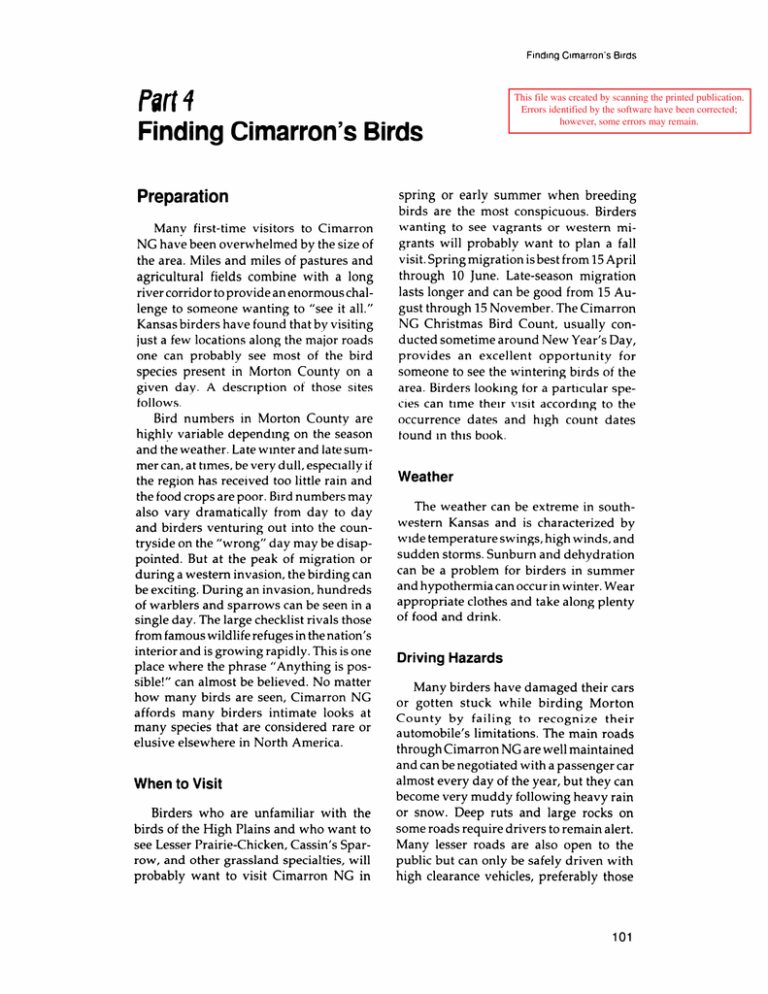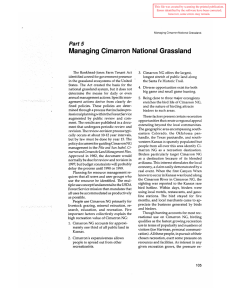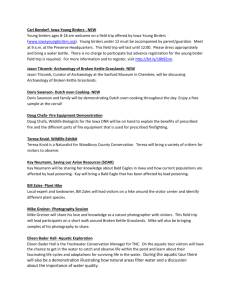f'irt Finding Cimarron's Birds
advertisement

Find1ng Cimarron's Birds
f'irt i
Finding Cimarron's Birds
PM4
Finding Cimarron's Birds
Finding Cimarron's Birds
This file was created by scanning the printed publication.
Errors identified by the software have been corrected;
however, some errors may remain.
Preparation
Many first-time visitors to Cimarron
NG have been overwhelmed by the size of
the area. Miles and miles of pastures and
agricultural fields combine with a long
Preparation
river corridor to provide an enormous chal-
lenge to someone wanting to "see it all."
Kansas birders have found that by visiting
just a few locations along the major roads
one can probably see most of the bird
species present in Morton County on a
given day A description of those sites
follows.
Bird numbers in Morton County are
highlv variable depending on the season
and the weather. Late winter and late sum-
mer can, at times, be very dull, especially if
the region has received too little rain and
the food crops are poor. Bird numbers may
also vary dramatically from day to day
and birders venturing out into the coun-
tryside on the "wrong" day may be disap-
pointed. But at the peak of migration or
during a western invasion, the birding can
be exciting. During an invasion, hundreds
of warblers and sparrows can be seen in a
single day. The large checklist rivals those
from famous wildlife refuges in the nation's
interior and is growing rapidly. This is one
place where the phrase "Anything is pos-
sible!" can almost be believed. No matter
how many birds are seen, Cimarron NG
affords many birders intimate looks at
many species that are considered rare or
elusive elsewhere in North America.
When to Visit
Birders who are unfamiliar with the
birds of the High Plains and who want to
see Lesser Prairie-Chicken, Cassin's Spar-
row, and other grassland specialties, will
probably want to visit Cimarron NG in
spring or early summer when breeding
birds are the most conspicuous. Birders
wanting to see vagrants or western mi-
grants will probably want to plan a fall
visit. Spring migration is best from 15 April
through 10 June. Late-season migration
lasts longer and can be good from 15 Au-
Manv first-time VISitors to Cimarron
NG have been overwhelmed by the size of
the area. Miles and miles of pastures and
agricultural fields combine with a long
river corridor to provide an enormous challenge to someone wanting to "see it all."
Kansas birders have found that by visiting
just a few locations along the major roads
one can probably see most of the bird
species present in Morton County on a
given day. A descnption of those sites
follows.
Bird numbers in Morton County are
highly variable dependmg on the season
and the weather. Late wmter and late summer can, at times, be very dull, especially if
the region has received too little rain and
the food crops are poor. Bird numbers may
also vary dramatically from day to day
and birders venturing out into the countryside on the "wrong" day may be disappointed. But at the peak of migration or
during a western invasion, the birding can
be exciting. During an invasion, hundreds
of warblers and sparrows can be seen in a
single day. The large checklist rivals those
from famous wildlife refuges in the nation's
interior and is growing rapidly. This is one
place where the phrase "Anything is possible!" can almost be believed. No matter
how many birds are seen, Cimarron NG
affords many birders intimate looks at
many species that are considered rare or
elusive elsewhere in North America.
gust through 15 November. The Cimarron
NG Christmas Bird Count, usually con-
ducted sometime around New Year's Day,
When to Visit
provides an excellent opportunity for
someone to see the wintering birds of the
area. Birders looking for a particular spe-
cies can time their visit according to the
occurrence dates and high count dates
tound in this book.
Weather
Birders who are unfamiliar with the
birds of the High Plains and who want to
see Lesser Prairie-Chicken, Cassin's Sparrow, and other grassland specialties, will
probably want to visit Cimarron NG in
spring or early summer when breeding
birds are the most conspicuous. Birders
wanting to see vagrants or western migrants will probably want to plan a fall
visit. Spring migration is best from 15 April
through 10 June. Late-season migration
lasts longer and can be good from 15 August through 15 November. The Cimarron
NG Christmas Bird Count usually conducted sometime around New Year's Day,
provides an excellent opportunity for
someone to see the wintering birds of the
area. Birders lookmg for a particular speoes can t1me their v1sit accordmg to the
occurrence dates and h1gh count dates
tound m th1s book.
Weather
The weather can be extreme in southwestern Kansas and is characterized by
w1de temperature swings, high winds, and
sudden storms. Sunburn and dehydration
can be a problem for birders in summer
and hypothermia can occur in winter. Wear
appropriate clothes and take along plenty
of food and drink.
Driving Hazards
Many birders have damaged their cars
or gotten stuck while birding Morton
County by failing to recognize their
automobile's limitations. The main roads
through Cimarron NG are well maintained
and can be negotiated with a passenger car
almost every day of the year, but they can
become very muddy following heavy rain
or snow. Deep ruts and large rocks on
some roads require drivers to remain alert.
Many lesser roads are also open to the
public but can only be safely driven with
high clearance vehicles, preferably those
The weather can be extreme in south-
western Kansas and is characterized by
wide temperature swings, high winds, and
sudden storms. Sunburn and dehydration
can be a problem for birders in summer
and hypothermia can occur in winter. Wear
appropriate clothes and take along plenty
of food and drink.
Driving Hazards
101
Part 4
Part 4
with four-wheel drive. Unimproved tracts
through the sandhills south of the Cimar-
ron River as well as the Turkey Trail east of
state highway 27 and the Cimarron River
stream bed east of the Wilburton Crossing
are all open to the public but can be very
challenging. Unless you have an excellent
four-wheel drive vehicle and considerable
off-road driving experience, it is best to
proceed on foot.
with four-wheel drive. Unimproved tracts
through the sandhills south of the Cimarron River as well as the Turkey Trail east of
state highway 27 and the Cimarron River
stream bed east of the Wilburton Crossing
are all open to the public but can be very
challenging. Unless you have an excellent
four-wheel drive vehicle and considerable
off-road driving experience, It is best to
proceed on foot.
pital on the west side of Elkhart can treat
most medical problems. Morton County
has excellent cellular phone service; so if
your car quits or if you need medical care,
help is only a phone call away.
Best Birding Stops
Elkhart Cemetery and Shelterbelt
Hiking Hazards
The most enjoyable method of birding
Morton County is on foot. In fact, it is the
Hiking Hazards
only way you are likely to find many birds
along the river. But hikers need to be pre-
pared for some problems that may arise.
Good shoes are a must as this area is a
paradise for plants with stickers, spines,
and needles. Long pants are recommended
even in hot weather. Loose soil and rocks
on many slopes make walking difficult
and somewhat dangerous. Some birding
spots are so seldom visited by other people
that if you fall or become stranded you
cannot count on being found. Use the same
caution you would when hiking in a wil-
derness area.
Prairie rattlesnakes (Crotalus viridis) are
common in the area. Birders may be the
most likely Cimarron visitors to encounter
this reptile because the rocky outcrops and
brushy draws that are its primary habitat
also provide good birding opportunities.
As local folks say, it is foolish to walk
around in this area without keeping one
eye on the ground in front of you. Bites
from these rattlesnakes usually pose little
threat to human life but can cause painful
swelling and permanent tissue and nerve
damage in the area of the wound. Health
complications are worse in children, so
youngsters should be supervised at all
times during warm weather.
Emergencies
Towing services and car repair are avail-
able in Elkhart, and Morton County Hos-
pital on the west side of Elkhart can treat
most medical problems. Morton County
has excellent cellular phone service; so if
your car quits or if you need medical care,
help is only a phone call away.
Best Birding Stops
Elkhart Cemetery and Shelterbelt
The most enjoyable method of birding
Morton County is on foot. In fact, it is the
only way you are likely to find many birds
along the river. But hikers need to be prepared for some problems that may arise.
Good shoes are a must as this area is a
paradise for plants with stickers, spines,
and needles. Long pants are recommended
even in hot weather. Loose soil and rocks
on many slopes make walking difficult
and somewhat dangerous. Some birding
spots are so seldom visited by other people
that if you fall or become stranded you
cannot count on being found. Use the same
caution you would when hiking in a wilderness area.
Prairie rattlesnakes (Crotalus viridis) are
common in the area. Birders may be the
most likely Cimarron visitors to encounter
this reptile because the rocky outcrops and
brushy draws that are its primary habitat
also provide good birding opportunities.
As local folks say, it is foolish to walk
around in this area without keeping one
eye on the ground in front of you. Bites
from these rattlesnakes usually pose little
threat to human life but can cause painful
swelling and permanent tissue and nerve
damage in the area of the wound. Health
complications are worse in children, so
youngsters should be supervised at all
times during warm weather.
Location: The Elkhart Cemetery is on
the north edge of town along the northern-
most street that connects state highway 27
and U.S. 56.
Emergencies
Description: The cemetery is a good
place to look for birds during migration
and in the winter. Red-naped Sapsucker,
Towing services and car repair are available in Elkhart, and Morton County Hos-
Red-breasted and Pygmy Nuthatches, and
Mountain Chickadees have all been re-
corded here. The shelterbelt across the
street to the north is also on city property.
Horses are sometimes allowed to graze
here so the fence may be electrified, but
access is unrestricted. This shelterbelt ap-
pears unremarkable, but it has produced a
long list of rarities in recent years. A male
102
Location: The Elkhart Cemetery is on
the north edge of town along the northernmost street that connects state highway 27
and U.S. 56.
Description: The cemetery is a good
place to look for birds during migration
and in the winter. Red-naped Sapsucker,
Red-breasted and Pygmy Nuthatches, and
Mountain Chickadees have all been recorded here. The shelterbelt across the
street to the north is also on city property.
Horses are sometimes allowed to graze
here so the fence may be electrified, but
access is unrestricted. This shelterbelt appears unremarkable, but it has produced a
long list of rarities in recent years. A male
Pyrrhuloxia was here for several months
in 1993. A wide diversity of flycatchers,
thrushes, warblers, and sparrows has been
recorded here. Bam Owls are often present
in the juniper trees.
Elkhart Sewer Ponds
Location: The sewer ponds are north of
the Elkhart Cemetery. To get there, turn
north on the dirt road just west of the
cemetery, jog left and back right and continue to the parking area and walk-through
gate that have been specifically provided
for birders.
Description: These cement-lined evaporation ponds are the largest body of water
for many miles in every direction. They act
like a magnet for migrating waterbirds.
The duck and shorebird list is impressive.
Red Phalarope and Sabine's Gull have both
been recorded here twice. Because many
migrants often stop very briefly, it is sometimes productive to make more than one
Hip to these ponds on a 0iven day to check
Finding Cimarron s Birds
for new arrivals.
ip to these ponds on a given day to check Point of Rocks
{rip to these pc
for new arrivals.
i eiven day
Cimarron NG Work Center
Cimarron NG Work Center
Location: Local residents and birders
who regularly visit the area know the facil-
ity as "the Work Center." It lies 2.5 miles
north of Elkhart east of state highway 27.
Birders may park at the entrance but must
leave room for other vehicles to pass
through the gates.
Description: The Work Center is the
maintenance headquarters for the Forest
Service ranching operations. The large
plantings of junipers and pines provide
refuge for many birds in winter and can
attract migrants as well. Birders are wel-
come to walk around the buildings. Sev-
eral records of Scrub Jay, Canyon and
Green-tailed Towhees come from here. All
the finch species have been seen here and
large numbers of sparrows can be expected
in winter. Townsend's Solitaires are nor-
mally present from September through
April, and Curve-billed Thrashers some-
times reside here. The first Pyrrhuloxia for
Kansas was found here in October 1989.
Middle Spring
Location: Middle Spring is reached by
turning west from state highway 27 about
eight miles north of Elkhart and just north
of the Cimarron River. Follow the winding
Location: Local residents and birders
who regularly visit the area know the facility as "the Work Center." It lies 2.5 miles
north of Elkhart east of state highway 27.
Birders may park at the entrance but must
leave room for other vehicles to pass
through the gates.
Description: The Work Center is the
maintenance headquarters for the Forest
Service ranching operations. The large
plantings of junipers and pines provide
refuge for many birds in winter and can
attract migrants as well. Birders are welcome to walk around the buildings. Several records of Scrub Jay, Canyon and
Green-tailed Towhees come from here. All
the finch species have been seen here and
large numbers of sparrows can be expected
in winter. Townsend's Solitaires are normally present tram September through
April, and Curve-billed Thrashers sometimes reside here. The first Pyrrhuloxia tor
Kansas was found here in October 1989.
rows.
and Rufous-crowned Sparrow have been
Middle Spring
create a classic migrant trap that has pro-
duced many rarities. A new foot trail
around this area has enhanced access for
birders. Flycatchers seem to be especially
drawn to this location. Cassin's Kingbird,
Ash-throated Flycatcher, and western
empids have all been seen here. A Great
Kiskadee was at Middle Spring for about
two weeks in late May 1995. This is a good
place to look for rare warblers and spar-
rows.
Location: Point of Rocks is about one
mile west of Middle Spring.
Description: Point of Rocks is the most
prominent outcropping of rocks in Morton
County. A walk around the rimrock can
occasionally produce good birds. Rock
Wrens nest here and can be seen from
April through October. The shrubs that
cover the slopes and ravines are the place
to look for elusive migrants such as Sage
Thrasher, Green-tailed and Canyon To-
whees, Rufous-crowned Sparrow and
MacGillivray's Warbler. Greater Roadru-
Boy Scout Area
Location: Middle Spring is reached by
turning west from state highway 27 about
eight miles north of Elkhart and just north
of the Cimarron River. Follow the winding
road about two miles southwest. The road
is well marked with signs.
Description: The willows and cottonwoods that line this small spring-fed stream
create a classic migrant trap that has produced many rarities. A new foot trail
around this area has enhanced access for
birders. Flycatchers seem to be especially
drawn to this location. Cassin's Kingbird,
Ash-throated Flycatcher, and western
empids have all been seen here. A Great
Kiskadee was at Middle Spring for about
two weeks in late May 1995. This is a good
place to look for rare warblers and spar-
is well marked with signs.
woods that line this small spring-fed stream
Location: Point of Rocks is about one
mile west of Middle Spnng.
Description: Point of Rocks is the most
prominent outcropping of rocks in Morton
County. A walk around the rimrock can
occasionally produce good birds. Rock
Wrens nest here and can be seen from
April through October. The shrubs that
cover the slopes and ravines are the place
to look for elusive migrants such as Sage
Thrasher, Green-tailed and Canyon Towhees, Rufous-crowned Sparrow and
MacGillivray's Warbler. Greater Roadrunners have been seen here several times.
The river below the point has also produced many rarities. Cassin's Kingbirds
are regularly seen here during September.
Point of Rocks is a good place to watch and
listen for birds migrating overhead and
along the Cimarron River corridor.
Location: This area is reached by turning east from state highway 27 about eight
miles north of Elkhart JUSt north of the
Cimarron R1ver. Follow the windmg road
northeast for 4.5 miles. An inconspicuous
trail about a half mile east of the cattle
guard on the main road leads down to the
river, or one can continue on to where the
road comes close to a fence, park the car,
and walk.
Description: Nicknamed the "Boy Scout
area" because of the large numbers of scouts
that formerly gathered for camp-outs here,
this section of the Cimarron River has long
been a favorite of Kansas birders. The riparian habitat is some of the best in Morton
County and this may be the most likely
place to see Ladder-backed Woodpecker.
A walk east along the north edge of the
flood plain leads to a high soil embankment created by a meander of the river.
Barn Owls reside in the many holes in the
bank but may be difficult to see. Greater
Roadrunner, Rock and Bewick's Wrens,
road about two miles southwest. The road
Description: The willows and cotton-
Point of Rocks
nners have been seen here several times.
The river below the point has also pro-
duced many rarities. Cassin's Kingbirds
are regularly seen here during September.
Point of Rocks is a good place to watch and
listen for birds migrating overhead and
along the Cimarron River corridor.
Boy Scout Area
103
Part 4
seen along the cliff and the first Canyon
Wren for Kansas was found here in 1992.
Mixed flocks of migrants often move
through the underbrush; a good strategy is
to follow the flock until all of the birds have
been identified. Most of the passerines on
the county checklist have been recorded
here at least once.
Forest Service Campgrounds and
Fishing Ponds
Locations: The Point of Rocks Fishing
Ponds are west of state highway 27 on the
road to Middle Spring. The Cimarron Recrea tion Area and the Mallard and Wilburton
Ponds are along the south river road east
of state highway 27.
Description: All of these locations have
water and cattails and afford birders the
opportunity to look for waterfowl and
marsh birds. Wintering Marsh Wrens can
be expected.
River Crossings
Locations: The Western Crossing is a
low-water crossing two miles east of the
Colorado line or about five miles southwest of Point of Rocks. The Cimarron River
Picnic Area is just east of the state highway
27 bridge. The Wilburton Crossing is five
miles north of Wilburton.
Description: All of these spots provide
easy access to the Cimarron River and are
good places to hike. The Western Crossing
has few trees but can still be good in migration. Ash-throated Flycatchers have been
nesting in boxes along the fence line south
of the river for several years. The Cimarron River Picnic Area is accessible in all
weather and leads to the head of Turkey
Trail. The Wilburton Crossing is probably
the best of the three for general birding.
North Fork
Location: This birding area is reached
by driving 14 miles north of Elkhart on
104
state highway 27 and then five miles west
on a gravel road. From this point an
unmaintained track leads north 1.5 miles
to a dense stand of trees. Park by the windmill and walk north and west through the
trees.
Description: This spot is not for everyone. The road can be very bad and is usually impassable in wet weather, and walking is difficult. However, this isolated riparian area has proven to be an excellent
migrant trap through the years and may
produce unusual birds at any season. The
road leading west from state highway 27
often produces Long-billed Curlews.
Mountain Plovers should be watched for
in this part of the county.
f
Lesser Prairie-Chicken Blinds
Location: The Forest Service places
two observation blinds each spring for
people to view prairie-chickens. The locations of the blinds may change year to
year. Currently, one viewing area is
reached by driving two miles north of
Elkhart then 2.5 miles west. From this point
drive north one mile, jog left at the windmill and then continue north for a short
distance. An active lek is on the east side of
the road here. The second viewing area is
reached by driving a little more than three
miles north of Wilburton, then turning
east on a winding road for a little over a
mile. An active lek is usually near the road
here.
Description: Each blind is a portable
wooden structure with bench seats and
openings through which to view the
prairie-chickens. It is best to arrive well
before dawn to avoid disturbing birds on
the lek. Photography opportunities are
excellent from these blinds. Some birds
normally return to these leks at sundown
each day. Birders traveling to Cimarron
NG specifically to see these birds should
contact or visit the Forest Service office
along U.S. 56 in Elkhart for current information.





